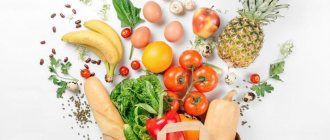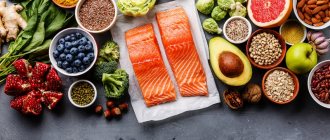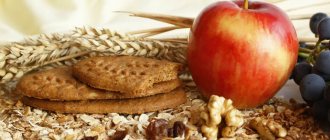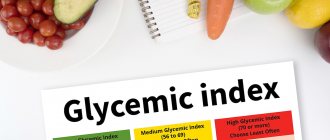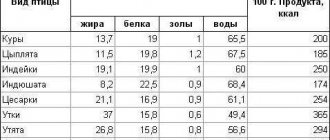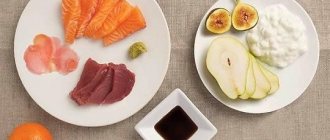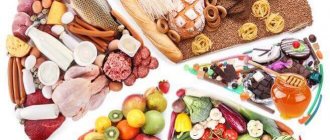Hello readers of my blog. Today I want to continue the topic of proper nutrition started in this article.
I have also already talked about the components of proper nutrition and the importance of balancing them.
Here, I want to talk about another fact that needs to be taken into account when compiling our daily menu - the compatibility of products for proper nutrition.
Eating compatible foods will help our body fully absorb the nutrients of a particular product.
How does this happen?
All food products have a different chemical composition, which of course affects their “digestibility” in our body: • this is the time that needs to be spent on digesting a certain group of products; • these are certain enzymes that process this food.
Let me explain this in a little more detail.
There are foods that are quickly digested, and there are foods that are slowly digested. If we consume them together, then food, which should quickly leave our body, will linger longer, the digestion process is disrupted - the food is not digested, but simply rots or ferments!
For example, an apple eaten at work (as a snack) leaves the stomach within half an hour. If we “snack” an apple after potatoes and meat (it takes more than 4 hours to digest), then it remains with these “slow” products and after 30 minutes it is already completely fermented.
In addition, a particular product in the stomach requires a different environment. So meat needs an acidic environment, and potatoes are “processed” into an alkaline environment.
The large intestine is also involved in all this. In it, food is no longer “processed” by our enzymes, but by our microorganisms - bacteria.
Let's roughly divide them into good and bad.
The good ones increase our immunity, help us “absorb” vitamins, process fiber, fight bad bacteria, etc.
Bad ones are all sorts of pathogenic microorganisms that are always present in our body. But some even help - they fight our “wrong” food, help quickly process it and remove it from the body.
So - raw plant food is processed by our well-wishers - beneficial bacteria, and the more and longer we consume such food, the more of them and the stronger our immunity becomes. And when we mix food - meat with salad, then a war begins in the intestines (and the consequences are gases) of who will win.
Therefore, it is very important for us to know how to properly combine foods with proper nutrition so that digestion time, enzymes, etc. more or less coincided, and there will be no imbalance in the process of their processing, because this is the basis of a healthy lifestyle .
Of course, we don’t know what we process with what, and what is combined with what.
But there was a doctor, Herbert Shelton, who offered us his table of food compatibility for proper nutrition.
There are controversial points in this table that modern scientists criticize (we know how they feel about everything that contradicts their dogmas). Of course, we cannot determine the correctness of all combinations of products, so whether to believe or not is up to you.
And further. You can always check with your body, and it will always tell you whether you have chosen the right combination or not.
How to Use a Food Combination Chart
The highlighted color means: Green cell – compatible products. Yellow - can be combined. Red – incompatible products.
For example, let’s look at how butter and bread combine. Butter - No. 3, bread - No. 7. We look at the intersection of No. 3 with No. 7 - we see green, ideal. That is, these are compatible products.
Shelton: separate nutrition and fasting
Dr. Shelton also insisted that his patients go on long fasts - he was sure that fasting had a healing effect. Interspersing periods of fasting with meals according to his method, over decades of his medical practice he cured thousands of people from such serious diseases as asthma, chronic bronchitis, hay fever, diabetes, neurosis and others. In any case, that’s what the nutritionist’s followers say. But in fairness, it should be said that for his, to put it mildly, unscientific medical activities (many of the doctor’s contemporaries called him nothing less than a charlatan), based on complaints from some injured patients, Herbert Shelton was arrested and imprisoned more than once. In addition, he was also a committed raw foodist and vegetarian.
Herbert Shelton devoted more than forty years of his life to studying the laws of separate nutrition. We hope that you will need much less time to decide whether it is worth adhering to the rules he created or whether it is better not to change your taste habits.
Explanation of some products from the table
No. 8. Tomatoes and sour fruits These are tomatoes and fruits that have acid - currants, strawberries, pineapples, pomegranates, strawberries, limes, tangerines, grapefruits and oranges.
No. 9. Semi-acidic fruits These include - quince, grapes, gooseberries and raspberries, blackberries, blueberries, cherries, gooseberries, nectarines and peaches, pears and apples, plums and apricots
No. 10. Sweet fruits These are figs, bananas, dried fruits, mangoes, persimmons, etc.
No. 11. Non-starchy vegetables Brussels cabbage, white cabbage and cauliflower, broccoli, parsnips, celery, sorrel, cucumbers, eggplant, lettuce, peppers (sweet), rutabaga. Sprouts: wheat, barley, alfalfa, etc.
No. 12. Starchy vegetables Artichoke, beans, carrots, corn, peanuts* Jerusalem artichoke, peas, potatoes, pumpkin.
* Peanuts, lentils, legumes and all grains combine both protein and starch.
Incompatibility and compatibility of products, separate nutrition according to Shelton (Table)
The essence of food compatibility is that ideally a person should eat 1 food item at a time. This way, all nutrients will be absorbed to the maximum extent possible.
Compatibility and incompatibility of products, separate nutrition according to Shelton
According to Shelton's separate nutrition method, naturopaths classified food products and divided them into groups:
| Squirrels | meat, fish, eggs, cheese, cottage cheese, nuts, mushrooms, beans, legumes, dry peas, eggplant, milk, sunflower seeds |
| Carbohydrates | potatoes, cereals, dried beans, pumpkin, zucchini, beets, carrots, cauliflower, sweet fruits - raisins, dried apricots, figs, persimmons, dates, dried pears and sweet apples |
| Fats | all types of vegetable oils, nuts, lard, fatty meat, sour cream, cream |
| Green vegetables | lettuce, celery, onion, spinach, sorrel, dill, parsley, cucumbers, cabbage, garlic, rhubarb, sweet peppers of all colors, all kinds are rare, etc. |
| Fruits | sour (including tomatoes), semi-sweet |
Green vegetables are compatible with the previous three groups. All of these groups, with the exception of green vegetables, are incompatible with each other. And in the groups themselves you cannot mix products. As you can see, low-fat lettuce is a desirable ingredient in all dishes. Bread and butter also go together.
Change your diet gradually, taking into account food compatibility and Shelton's principles of food division.
Using this classification, you can choose your daily diet so that the foods are not only compatible, but also match the proportion of acidic and alkaline foods, which should be about half.
As you gradually change your diet, increase your consumption of raw foods, as they provide the energy the body needs and cannot get from another source.
Table of compatibility and incompatibility of products according to Shelton
| Food | Compatible with products: | Incompatible with products: |
| Lean meat, lean fish, lean poultry | • Green vegetables; • Vegetables that do not contain starch | • Pulses; • butter, cream; • sour cream; • vegetable oil; • sugar, condit. products; • bread, cereals, potatoes; • all types of sour fruits, tomatoes; • all types of sweet fruits, dried fruits; • milk; • cottage cheese, fermented milk. products; • cheese, feta cheese; • eggs; • nuts |
| Pulses | • Sour cream, grows. oil; • Vegetables that do not contain starch (except for potatoes); • vegetables that are green and do not contain starch | • lean meat and fish, lean poultry; • sugar, condit. products; • all types of sour fruits, tomatoes; • all types of sweet fruits, dried fruits; • milk; • cottage cheese, fermented milk. products; • cheese, feta cheese; • eggs; |
| Drain oil, cream | • Bread, cereals, potatoes; • sour fruits, tomatoes; • starchy vegetables; • green and non-starchy vegetables | • lean meat, lean fish, lean poultry; • vegetable oil; • sugar, confectionery; • all types of sweet fruits, dried fruits; • cottage cheese, fermented milk products; • eggs; • nuts |
| Sour cream | • Grain legumes; • bread, cereals, potatoes; • sour fruits, tomatoes; • starchy vegetables; • green and non-starchy vegetables; • cottage cheese, • fermented milk products | • lean meat, lean fish, lean poultry; • sugar, confectionery; • milk; • nuts |
| Vegetable oil | • Grain legumes; • bread, cereals, potatoes; • sour fruits, tomatoes; • starchy vegetables; • green vegetables, non-starchy vegetables; • nuts | • lean meat, fish, poultry; • drained oil, cream; • sugar, confectionery; • milk; • cottage cheese, fermented milk products; • cheese, feta cheese; • eggs |
| Sugar, condit. products | • Green vegetables, non-starchy vegetables | • Meat, fish, lean poultry; • grain legumes; • drained oil, cream; • sour cream; • vegetable oil; • bread, cereals, potatoes; • all types of sour fruits, tomatoes; • all types of sweet fruits, dried fruits; • starchy vegetables; • milk; • cottage cheese, fermented milk products; • cheese, feta cheese; • eggs; • nuts |
| Different types of bread, cereals, potatoes | • Butter; • cream; • sour cream; • vegetable oil; • starchy vegetables; • green vegetables, non-starchy vegetables; | • Meat, fish, lean poultry; • sugar, confectionery products; • all types of sour fruits, tomatoes; • all types of sweet fruits, dried fruits; • milk; • cottage cheese, fermented milk products; • eggs |
| All types of sour fruits, tomatoes | • Butter and cream; • sour cream; • vegetable oil; • green vegetables, non-starchy vegetables; • cheese, feta cheese; • nuts; | • Meat, fish, lean poultry; • grain legumes; • sugar, confectionery products; • bread, cereals, potatoes; • milk; • eggs |
| All types of sweet fruits, dried fruits | • Green vegetables, non-starchy vegetables; • cottage cheese, fermented milk products. | • Meat, fish, lean poultry; • grain legumes; • drained oil, cream; • sugar, confectionery products; • bread, cereals, potatoes; • cheese, feta cheese; • eggs |
| Green vegetables, non-starchy vegetables | • Lean meat, lean fish, lean poultry; • grain legumes; • butter and cream; • sour cream; • vegetable oil; • sugars, confectionery products; • sour fruits, tomatoes; • bread, cereals, potatoes; • sweet fruits, dried fruits; • starchy vegetables; • cheese, feta cheese; • cottage cheese, fermented milk products; • eggs; • nuts; | • Milk |
| Starchy vegetables (except potatoes) | • Grain legumes; • butter and cream; • sour cream; • vegetable oil; • bread, cereals, potatoes; • green and non-starchy vegetables; • cottage cheese, • fermented milk products; • cheese, feta cheese; • nuts; | • Sugar, confectionery products |
| Milk | • Meat, fish, lean poultry; • grain legumes; • sour cream; • vegetable oil; • sugar, confectionery products; • bread, cereals, potatoes; • all types of sour fruits, tomatoes; • green vegetables, non-starchy vegetables; • cottage cheese, fermented milk products; • cheese, feta cheese; • eggs; • nuts | |
| Cottage cheese, all types of fermented milk products | • Sour cream; • sweet fruits, dried fruits; • starchy vegetables (except potatoes); • green vegetables, non-starchy vegetables; • cheese, feta cheese; • nuts | • Meat, fish, lean poultry; • grain legumes; • drained oil, cream; • vegetable oil; • sugar, confectionery products; • bread, cereals, potatoes; • milk; • eggs |
| Cheese, feta cheese | • Sour fruits, tomatoes; • starchy vegetables (except potatoes); • green vegetables, non-starchy vegetables; • cottage cheese, fermented milk products. | • Meat, fish, lean poultry; • grain legumes; • vegetable oil; • sugar, confectionery products; • all types of sweet fruits, dried fruits; • milk; • eggs |
| Eggs | Compatible with green and non-starchy vegetables | • Meat, fish, lean poultry; • grain legumes; • drained oil, cream; • vegetable oil • sugar, confectionery products; • bread, cereals, potatoes; • all types of sour fruits, tomatoes; • all types of sweet fruits, dried fruits; • milk; • cottage cheese, fermented milk products; • cheese, feta cheese; • nuts |
| Nuts | • Vegetable oil; • sour fruits, tomatoes; • starchy vegetables (except potatoes); • green and non-starchy vegetables; • cottage cheese, all types of fermented milk products. | • Meat, fish, lean poultry; • drained oil, cream; • sour cream; • sugar, confectionery products; • milk; • eggs |
Table of product incompatibility and harm to the body
This table lists products whose combinations in one form or another can lead to negative consequences for the body.
| Incompatible products | Harm to the body, side effects |
| SEAFOOD + TOMATOES | Causes nausea, intestinal upset, and the properties of protein are leveled. |
| CUCUMBERS + TOMATOES, HOT PEPPERS | Destroys vitamin C |
| BEEF + CHESTNUT | Impairs digestion |
| WHITE RADISH + APPLE, MANDARNINE, TOMATO, GRAPES | Causes a sore throat |
| BEEF WITH YOUNG GARLIC | Poison for the whole body! |
| CARROTS + WHITE RADISH | Causes blood cancer |
| LAMB + TEA | Impairs digestion |
| SODA DRINKS + SPICY FOODS | Causes diseases of the gastrointestinal tract (GIT) |
| BEEF + FISH | Poison for the liver and kidneys. They don't fit in any way! |
| ONION + GARLIC | Causes intestinal cramps and impairs digestion. |
| CARROTS + VODKA | Causes severe liver poisoning |
| CORN + BUCKWHEAT | It provokes skin diseases, worsens metabolism, and concentration decreases. |
| PRAWNS + PEPPER, TOMATO | Poison for the whole body! |
| SOY MILK + EGG | The properties of protein are leveled, and the digestibility of products deteriorates. |
| BEER + SAUSAGES or GRILLED SAUSAGES | Causes cancer! |
| RABBIT + CELERY | Causes hair loss and dullness. From the gastrointestinal tract - diarrhea. |
| LIVER + CAULIFLOWER | Poison for the whole body! |
| TEA + EGG, TOFU CHEESE | Impairs digestion. |
| FISH + PICKLES | Poison for the whole body! Causes cancer! |
| MEAT + TEA | It neutralizes the properties of protein and is harmful to the intestines. |
| RABBIT + DUCK | Causes diarrhea, chills, weakness in the body. |
| LAMB WITH GINGER | Causes dry mouth, sore throat, kidney pain. |
| HONEY WITH GARLIC AND ONION | Impairs vision! |
| GREEN BEANS + HONEY | When consuming foods in this combination, vitamin B1 is destroyed. |
| VODKA + PEACH | In any form, from compote to the fruit itself, it causes dizziness, nausea, and arrhythmia. |
| VODKA + TOMATO | In any form, including with tomato juice, it causes kidney stones, pulmonary diseases, oxygen starvation... |
| BANANA + MELONS | Provokes kidney failure and joint diseases. |
| CHICKEN + SESAME, CHAMOMILE TEA | Poison for the whole body! |
| SOY MILK + HONEY | Causes diarrhea, tinnitus. |
| VINEGAR + CARROTS | Makes carrots useless for the body, all vitamins disappear. |
| CHICKEN + CELERY, MUSTARD | Reduces energy activity, this combination is dangerous for the kidneys. It also reduces potency and negatively affects sperm. |
| PORK WITH PEAS | Causes bloating and increased gas formation. |
| CRAB + PEANUTS | Impairs intestinal motility and causes indigestion. |
| RADISH + BLACK MUSHROOMS | Causes skin allergies. |
| MILK + CHOCOLATE | Causes dry hair and impairs digestion. |
| BANANA + POTATOES | This combination is extremely harmful to the skin, blackheads may appear... |
| VODKA + SODA DRINKS | A terrible blow to the stomach, liver and kidneys at the same time! This combination provokes cardiovascular diseases. |
| MONSOLUM GLUTAMATE + EGG | In any combination, a terrible poison for the entire body, leading to death! |
| VODKA + COFFEE | Impairs cerebral circulation. |
| TOFU CHEESE + SPINACH | Digestion worsens, and bloating often occurs. |
| BEER + MEAT SOUP | Very harmful to joints, kidneys and gallbladder. |
| YOUNG GARLIC + VODKA | Provokes gastrointestinal diseases, hemorrhoids, bleeding. |
| BEER + SHELLS | Provokes cancer, kidney stones and gall bladder. |
| VODKA + TEA | Completely incompatible drinks provoke heart and kidney diseases. |
| LAMB + PUMPKIN, WATERMELON | Reduces energy activity, negatively affects sperm and the body’s lymphatic system |
| MILK + POMEGRANATE, GRAPES, ROSE HIP | Causes nausea, dizziness, bloating, and intestinal upset. |
| CUCUMBERS + PEANUTS | This combination is extremely bad for the kidneys. Causes diarrhea. |
| BEER + VODKA | A terrible blow to the liver, kidneys and heart |
5 additional tips for separate meals
In his book, Dr. Shelton also provides practical advice. They relate to food temperature, drinking regime, recommendations for milk and notes on the use of melons.
- Chilled drinks are harmful. To warm food, the body spends a tremendous amount of energy. Cold water does not enter the body's cells. And finally, cold foods stop the work of pepsin in the gastric juice. Ice food acts as stress on the gastrointestinal mucosa, putting it into a “feverish state.”
- Hot food is also harmful. You should not eat large amounts of hot food. It reduces the tone of the stomach, depriving it of “strength and energy.” With such improper eating, the glands of the stomach suffer. They perform their functions best at temperatures up to 40°C. Temperatures above 60°C lead to the destruction of the parietal cells of the stomach, which produce hydrochloric acid.
- Shelton, talking about the drinking regime, means drinking plenty of fluids. According to his rules, you should drink 4 hours after a protein meal, 2 hours after a starchy meal and 30 minutes after fruit. Drinking water before meals dilutes digestive juices. And food that is not broken down properly will leave the stomach. You should drink water 10-15 minutes before meals.
- Do not mix milk with other foods. You should not drink it after meals, in which case it stops the secretion of juices in the stomach. And after sour fruits you can drink it only after half an hour.
- Melons are eaten separately from any food. Melons are an easily digestible food that is digested in the intestines; it does not linger in the stomach. Eating melons with food processed in the stomach will keep them there for a long time, leading to indigestion.
Theory about compatibility and incompatibility of products
The method used by millions of people was invented by Herbert Shelton, a nutritionist and part-time naturopath. In the 20s of the 20th century, his first book was published, which talked about the correct combination of food products. In it, the author attempted to divide everything we eat into several groups and study the properties of each of them.
The result of the work was the theory formulated by Shelton about the compatibility and incompatibility of nutrients entering our body. Some of them complement each other, and some, when combined, turn into poison. This assumption became the basis for creating a special diet in which dishes are divided depending on which enzymes are involved in their digestion.
Advantages of separate power supply
The diet is based on the consumption of natural products with minimal processing. Semi-finished products, fast food, sugar are not recommended. Those. the body receives only useful substances that saturate well, while the caloric content of the diet is reduced, which promotes weight loss.
The selection of products is carried out consciously and thoughtfully, which develops the skill of meal planning.
It is not difficult to formulate a diet; many foods are allowed, from which it is easy to prepare delicious dishes. When switching to this regime, no radical changes in eating habits are required.
With separate meals, most foods are allowed to be consumed.
Basic rules for following a diet
- We do not combine saturated proteins of different composition in one meal. That is, we do not combine fish and meat, eggs and nuts. Otherwise, this will lead to increased gas formation, poor health, slagging of the body and, as a result, the possible appearance of excess weight.
- We eat proteins separately from fats. This is an extremely harmful combination. The bottom line is that butter and vegetable oils (sources of fat), as mentioned above, do not allow gastric juice to be produced in the required quantity.
- You need to start eating only when you feel a strong feeling of hunger (this is when you want to eat even something not very tasty).
- Snacks between main meals are unacceptable, as they disrupt the digestion process.
- You should not drink water immediately after eating (it is acceptable to drink liquid 10-15 minutes before a meal). After fruits, you can resume your water regime within half an hour, after starchy foods - after a couple of hours, and after protein foods - no earlier than 4 hours.
- When consuming any food, you need to chew it thoroughly, moistening it with saliva. Nothing should distract from the meal, and after eating there should be a short rest. You cannot overeat - the volume of a portion of food should be approximately equal to cupped palms (the stomach is no more than 2/3 full).
- Food should be at a comfortable temperature. Priority remains with products grown in the native region - the body is initially configured to assimilate them, while foreign products can cause serious difficulties.
- Approximately half of the daily diet should come from raw plant foods (note: it is better to eat fruits separately from any other foods).
Experts' opinions
As early as 1935, Stuart Baxter showed that the pancreas secretes digestive enzymes simultaneously, regardless of whether the food eaten is carbohydrate or protein.
Elena Chedia, a nutritionist of the highest category at the Clinic of the Institute of Nutrition of the Russian Academy of Medical Sciences, points out that nutritionists are extremely skeptical about separate nutrition. She writes that the attempt to explain the rationality of separate nutrition by the processes of fermentation and rotting that occur when different types of products are combined is far from reality. With normal functioning of the gastrointestinal tract and the absence of enzyme deficiency, no “rotting” is possible. If there is any disease, it must be treated either with special diets or medications, and the human stomach is formed so as to digest mixed food, and not its individual types in turn.
A detailed criticism of the separate nutrition system was given by L. S. Vasilevskaya, Doctor of Medical Sciences, Professor of the Research Institute of Nutrition of the Russian Academy of Medical Sciences, leading specialist of the Russian Federation in the physiology of nutrition and digestion. Vasilevskaya notes that the hypotheses underlying the separate nutrition system do not agree with the data obtained over many years by medical science (research by I. P. Razenkov (1948), A. D. Sineshchekov (1970), G. K. Shlygin ( 1989, 1997), HN Munro (1970) and other physiologists). Endogenous proteins of the body are constantly secreted into the digestive system, which, in addition to their enzymatic function, act as suppliers of amino acids. Thanks to this process, the amino acid composition of chyme is equalized. Consequently, with separate nutrition, the body has to constantly produce additional secretions to correct the composition of the chyme in order to ensure normal absorption of nutrients from the intestines, which is an additional burden on the gastrointestinal tract and the entire body. According to L. S. Vasilevskaya, the assumption that various enzymes inhibit each other, not promoting better digestion, is refuted by research data.
L. S. Vasilevskaya also notes that G. Shelton’s concept does not take into account the centuries-old habits of people to consume mixed foods. Over the course of many generations, the development of enzymatic adaptation to familiar food is observed, which leads to rapid and optimal homeostasis of functions in the body.
German nutritionist Karina Pohes characterizes the Hay-Shelton system as follows: “Scientifically, this is complete nonsense, since the body is able to process both proteins and carbohydrates at the same time.”
Doctor of Medical Sciences, Head of the Department of Metabolic Diseases of the Research Institute of Nutrition of the Russian Academy of Medical Sciences Yu. P. Popova believes: “The doctrine of separate nutrition has no scientific basis.”
American nutritionist T. Freumin classifies all types of separate nutrition as persistent myths about health. She points out that in fact, there is not a single correct statement in the theory of separate nutrition. Combining foods in itself does not affect the level of acidity in the gastrointestinal tract, and the ability to digest and absorb protein does not depend at all on which foods are digested at the same time.
K.b. n. physiologist R. S. Minvaleev claims that there is simply no serious theoretical justification for the concept of separate nutrition, and calls Herbert Shelton “ignorant in elementary issues of gastroenterology.” According to him, Shelton had a very rough idea of the existence between the stomach and the small intestine of the duodenum, in which proteins (by the pancreatic enzyme trypsin and other proteinases), fats (by lipases with the participation of hepatic and cystic bile) and carbohydrates (various amylases) are simultaneously digested ), that is, there is simply no “separate” digestion, at least in the duodenum. Minvaleev also notes that the pleasure hormone serotonin is produced with a mixed diet, but not with a separate diet. Thus, separate nutrition leads to prolonged unmotivated depression, and in this case, a return to a mixed diet can replace antidepressants.
The theory of separate consumption of “carbohydrates” and “proteins” is considered unfounded also because it ignores the fact that all carbohydrate-rich foods contain significant amounts of protein.
Experts point out that only a combination of different products best ensures that the body receives the nutrients it needs from food; With a wide variety of substances, it is easier for the body to “select” the necessary ones. The processes of assimilation and metabolism of microcomponents are often sharply activated in the presence of other nutrients. The most favorable from the point of view of the “work” of all enzymes of pancreatic juice is the intake of the most varied food containing optimal ratios of proteins, fats and carbohydrates, in which the body simultaneously receives amino acids, fatty acids, and monosaccharides, that is, building material and energy carriers . The entry into the blood of only “building material” without energy and, conversely, energy without “building material”, undoubtedly creates difficulties for the body
